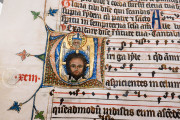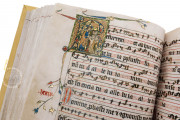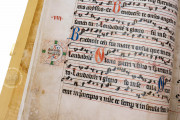The Pelplin Gradual is an essential witness to Christian Latin chant for the sacrament of the Mass from eastern Europe. It was made at and for the Cistercian monastery at Pelplin in the second half of the fourteenth century. Its contents include the chants for most feast days throughout the year, notated in the characteristic Hufnagel notation used east of the Rhine River. Its painted decoration comprises ten historiated initials and three marginal scenes, including some with unusual and intriguing subjects.
The manuscript contains chants of the Mass as well as hymns and other chants for the prayer service of Terce presented in two annual cycles, the first devoted to feasts commemorating events in the life of Christ and Sundays and the second concerned with saints' feasts.
Surprising Subjects
Some of the historiated initials that introduce major holidays feature the expected scenes, for example, the Nativity of Christ for Christmas (fol. xiii [red] verso) and a portrait of the standing Saint Peter holding the keys to heaven for his feast day (fol. xlv [black] verso).
Some pictured themes are appropriate but not expected. The Descent into Limbo—the resurrected Christ rescuing the Old Testament worthies—fills the initial R that opens the first chant for Easter (fol. lxxix [red] verso). The Tree of Jesse—a representation of Christ's lineage based on a prophecy of Isaiah—introduces the feast of the Annunciation to the Virgin (fol. xxviii [black] recto).
Doubled Subjects
The gradual includes two representations of the Holy Face—the image of Christ's face impressed on a cloth—first in the margin at the second Sunday after Epiphany (fol. xvii [red] recto) and later in an entirely unexpected place: in the historiated initial for the feast of the Ascension (fol. xciii [red] verso). This rendition is highly unusual in that a bearded bishop with a halo holds the cloth aloft.
There are also two historiated initials with the Coronation of the Virgin, one for the Assumption of the Virgin (fol. lii [black] recto) and the other for the feast of the 11,000 Virgins of Cologne (fol.lx [black] recto). In the first, the Virgin and Christ greet one another with texts written on speech scrolls.
Focus on Bernard
Saint Bernard of Clairvaux (d. 1153) is an important figure in the history of the Cistercian order of monks and a widely influential theologian. Accordingly, the chants for his feast day are embellished by an image of the haloed saint enthroned, his abbot's crozier in one hand and a book in the other.
Pen-Flourished Initials
The text is written in Gothic Textualis, the customary script for liturgical books. The letter shapes of most of the historiated initials are composed of blue and red segments and are flourished with scrolling penwork. Hundreds of pen-flourished initials introduce the chants: five are especially large and elegant, with scrollwork filling the initials and trailing into the margins.
Original Foliation
The manuscript's leaves were numbered at the time it was made with Roman numerals written in the outer margins of the left-hand pages in two sequences, the first (in red) running from i to cxxi (1-121) and the second (in black) from i to lxv (1-65), with unnumbered leaves before, in between, and following. This scheme distinguishes the two liturgical cycles of temporal and sanctoral.
Abbey of Pelplin
The Cistercian monastery was established at Pelplin in Pomerania (modern northern Poland) in the thirteenth century, and the gradual dates from its heyday in the following century. The manuscript was once in the collection of the Biblioteka Seminarium Duchownego and was transferred to the Biblioteka Diecezjaln in the twenty-first century.
We have 1 facsimile edition of the manuscript "Pelplin Gradual": Graduale de Tempore et de Sanctis facsimile edition, published by Bernardinum Wydawnictwo, 2024
Request Info / Price



























